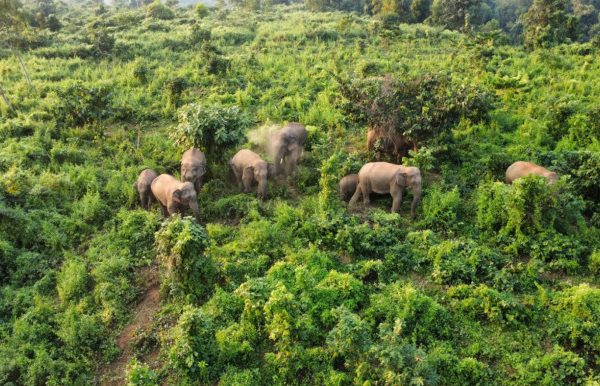New guests in the wilderness: Can Sherpur forests sustain more elephants?
- Update Time : Friday, January 3, 2025

Sherpur Correspondent
Among all the bad news regarding the country’s forests and wildlife, the number of elephants roaming in the border forests in Sherpur, Jamalpur and the Mymensingh belt may be on the rise, according to locals and forest officials.
While there is no recent census on elephants in the country, it is evident from drone photos and local eyewitnesses that a good number of calves have been added to the elephant herds visiting these areas.
Although these elephants are migratory in nature, roaming across the Bangladesh-India border, recent changes have led to the majestic animals staying longer, if not permanently, within Bangladesh territory.
Forest officials claim that the apparent increase in elephant population is a sign of success in conservation.
However, human-elephant conflict in the area is also high as the animals raid crop fields for food while the farmers take preventive measures to save their paddy. Casualties on both sides are also regular. This also indicates that natural food sources for the elephants are scant.
THIS CONTEXT BEGS THE QUESTION: CAN THESE FORESTS SUSTAIN A HIGHER NUMBER OF THESE ‘GENTLE GIANTS’?
To find an answer to this, we travelled along the whole stretch of forests between Mymensingh and Jamalpur under the Mymensingh Forest Division and spoke to dozens of farmers as well as officials and experts.
TERMINALLY ALTERED FORESTS
The forests in these areas are highly degraded. Although they are not devoid of trees, they are basically a green desert composed of patches of monocultures of a couple of species.
Originally dominated by Sal and associated species, the former only remains on the sides of the roads in the best case. As the Sal forests used to be clear-felled to extract timber till 1989, the associated plant species were wiped out, although Sal survived. Now, even though clear felling is not practised anymore, the Sal patches are devoid of diversity, which is not ideal for wildlife.
Other parts of the forests are mostly Acacia plantations and, in the worst-case scenario, Eucalyptus monoculture. In some parts, we did not find natural forests even after walking a mile towards the border. Even just beside the no man’s land, there are monoculture plantations. The somewhat natural forests that still remain are also located near the border, which is where the elephants reside and forage.
Since natural patches are so miniscule compared to plantations, elephants often come down to croplands in the plains, especially when the paddies ripen. They also forage bananas, jackfruit and other orchards planted by the locals.
Locals said there were many orchards in and around the forest in the past, but nowadays, such projects cannot be protected from the elephants.
Farmers put up electrified fences to protect their crops and try to drive away the herds with torches, firecrackers, sticks, etc, sometimes leading to the death of elephants.
The government has been trying to stop this by, firstly, compensating farmers for damaged crops, and, secondly, by bringing the elephant killers to book.
Compensating the farmers is also a complicated issue, and we found some farmers who feel they are inadequately compensated or not compensated at all. However, this dissatisfaction is often unjustified because the Forest Department cannot pay compensation money to farmers (illegally) cultivating khas lands or land belonging to the Forest Department, which is a common practice, Tanvir Ahmed Emon, Assistant Conservator of Forests (ACF) at the Rangtia range in Sherpur, told this correspondent.
The Forest Department has a lot of lands encroached upon by people across the country. In the Rangtia range, 1,400 acres of forest land is encroached and illegally cultivated.
NOT A GOOD NEWS FOR THE LOCALS
The conflicts between the gentle giants and local inhabitants mean that the reported increase in the elephant population is not good news for the locals. They openly expressed worries about it.
“They eat our crops, destroy houses, kill people. We don’t like elephants,” Abdus Samad, a farmer in his 60s from Nalitabari, told this correspondent, standing outside an Acacia patch on the outskirts of a crop field in Hatipagar village.
As evident in the name of the village (Hati meaning elephant), this whole range of forest was once an elephant habitat, later ‘shared’ by humans. The only catch is, humans now cannot tolerate the wildlife. Abdus Samad’s grandfather came from further south — Gafargaon in Mymensingh — before the Liberation War. This is a common story of almost all the villagers living in this belt.
However, people in the area say elephants have been raiding their locality since the early 2000s. According to Monirul H Khan, a professor of zoology at Jahangirnagar University, elephants used to migrate in the area all the time, but they used to stay for a shorter period, which is why many were unaware of their existence in the forests.
Because of cashew nut farming in Indian hills, Indian farmers push elephants away as well. Although there are fences on the Bangladesh-India border, Indian border guards open the gates when elephants come nearby. Also, recent landslides damaged some parts of the fences, giving a free pass to the animals.
“The other day, I saw a herd of 40-50 elephants. Eight to 10 of them were baby elephants,” Abdus Samad said, claiming that the number of the animals is on the rise.
We asked several people along the border if they thought the elephant population was growing.
“They give birth like cattle. Cattle are sold in the market, elephants are not, so they are increasing in number,” said another farmer named Aminul Islam from Daodhora village in Jhenaigati upazila of Sherpur.
Locals, of course, give a varied number of elephants living in the area. They assume numbers to be between 100 and 200.
Professor Monirul H Khan said it is not possible to confirm if the numbers are rising without a census.
Aminul also said why he disliked elephants. “As soon as they come five kilometres near the village, our sleepless nights begin. Sometimes, they take a week to come closer; sometimes, they arrive the next night. We have to drive them away.”
This is when the casualties occur.
The government pays Tk3 lakh to a family if someone is killed by the elephants outside the forest. For the seriously injured, the amount is Tk1 lakh, and for damages to crops and other assets etc, a compensation of Tk50,000 is given.
Professor Monirul Khan said that the elephants are not to blame for the conflicts.
“Elephant herds graze and browse in one area and move to the next. They travel through the same routes generation after generation. It is humans who have extended their territory into the elephants’ one,” said the professor. “It is clearly not the fault of the elephants. They need a large area to survive; they cannot be kept in a small area.”
He added that Asian elephants live in hill forests and do not like the plains much. They come down when there is a food shortage in the hills. Monoculture of exotic plant species in forest areas increases food scarcity for elephants.
Professor Khan mentioned that only a part of native plant species sustains elephants.
Can the majestic guests sustain?
How can the conflict between humans and elephants be minimised? We asked locals, officials and experts.
Farmer Aminul Islam said planting fruit trees like banana, jackfruit, lotkon, guava and some other native species in the forest would help. Although elephants eat some bark from Acacia trees but not the leaves, the monoculture cannot sustain the animals. Elephants are herbivores, and they eat a range of plants, including grasses, fruit, and roots.
A cowhand, Illias, said, the Forest Department is planting monocultures and even mixed plantations under the Sufal (Sustainable Forests and Livelihoods) project, but has done nothing for the elephants.
“Humans have enough space for them in the area, elephants also have forests for them. Only thing missing is their food,” Illias said. He added that mixed fruit plantations replacing acacia are now bringing back birds, indicating a desirable change in the forests.
Tanvir Ahmed Emon, the forest official, said acacia plantation is easy for the seriously understaffed Forest Department as cattle and elephants do not harm the seedlings. Also, elephants mature fast, in 10 years, to bring incomes to the local beneficiaries of the plantation programmes, aimed at income generation of the forest-dependent population so they do not collect timber from the ‘core’ forests.
However, he mentioned that the interim government had prohibited acacia plantations in the forests, so the FD is now implementing only mixed species plantations with bohera, arjun, haritaki etc, which are all native species.
The forest official said that the Forest Department is trying its best to sustain the existing elephants.
He noted that the department has created some forests near the Bangladesh-India border lands that now provide shelter to these elephants. Some fodder species were also planted inside these newly created forest areas.
Terming elephants ‘natural foresters,’ the ACF said that human disturbances inside these forest areas are very little due to the presence of elephants.

















